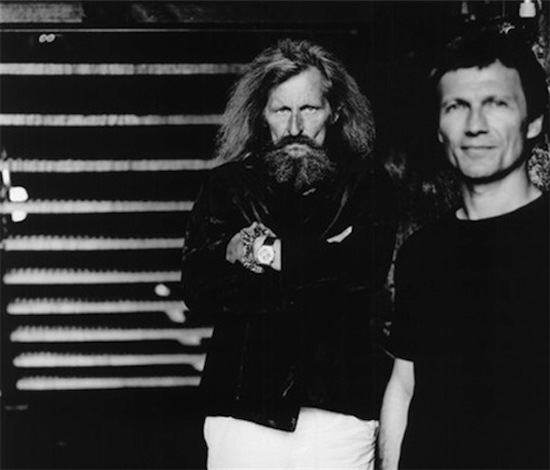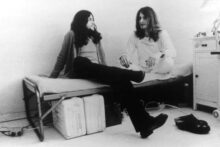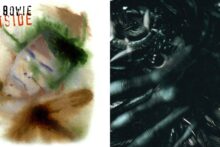Brian Eno would declare the Dingerbeat devised by Neu!’s Klaus Dinger to be one of the three great beats of the 1970s, along with James Brown/Clyde Stubblefield’s funk and Fela Kuti/Tony Allen’s Afrobeat. It’s also known as motorik, a word with an ultra-modernistic, Teutonic sheen but one which was actually coined to describe the work of the pre-war German composer Paul Hindemith who, in works like the Sonata For Solo Cello Opus 25, sought to emulate the industrial rhythms that were a new addition to the sonic environment of the early 20th century. Today, in the early 21st century, motorik is ubiquitous. Linear and propulsive, it features in the music of Toy, Cold Pumas, Kasabian and The Horrors, among many others. Even The Manics have taken on board its Germanic element to a degree with their latest album Futurology, while Noel Gallagher has declared himself a Neu! fan.
This isn’t entirely surprising – for those with its interests at heart, popular rock is in ecological crisis, with few places left to "go" structurally. Dingerbeat, which has been characterised by musician and Can associate Jono Podmore as a 4/4 tempo with the accents constantly on the beat, represents a new lifeline. Traditional West African-based African-American musics like ‘The Funky Drummer’ backbeat are, he says, "structured over two bars – one bar with the accent on the beat, the next with the accent off the beat. This forms a duality – breathe out, breathe in. The Dingerbeat just breathes out – a single line, a constant process. Not circular but driving from A to wherever." With its tantric build-up of intensity and fast-moving, picaresque backdrop, the motorik beat offers a thrillingly accessible alternative to the old model. Play motorik and you can hurtle past the old necessities of bridge and chorus like so many turn-offs and service stations. Fast forward, onward.
And yet, it’s not so long ago that motorik as a precursor to today’s rock languished in relative oblivion. Sure, there were Can and Kraftwerk, who could intermittently be claimed to be practitioners of the genre – ‘Autobahn’ is an obvious example, though it bowls along at a relatively languid pace and goes through various gears, while Can’s ‘Moonshake’, a small, perfectly formed piece of robo-pop from 1973, inspired a UK band of the same name. Then there was ‘Mother Sky’, which proceeds across its own landscape in a manner celebrated by Loop on their cover of the song in the 1980s, or Faust’s more primitive take on the beat, ‘It’s A Rainy Day, Sunshine Girl’. Faust, Can and Kraftwerk albums were available in the late 1980s. Much harder to get hold of, however, were the albums of Neu! – and, with no YouTube to sate the curious, they become the stuff of mythology, tantalisingly alluded to by older music press journos, namechecked by Sonic Youth in their songs.
Neu!’s back catalogue was eventually reissued thanks to the best efforts of German rock star Herbert Grönemeyer, who decided to start his own label, not least to benefit other German artists less fortunate than himself. Prior to that, however, throughout the 1990s, a series of disputes between Michael Rother and the irascible, embroiled Dinger (who released Neu! material unauthorised by his own partner) meant that the only way you could actually get to hear this legendary 70s duo was via old rare vinyl or cassettes. My friend, the late Neil Jones, made me a compilation of Neu! material, along with similarly unavailable tracks by Harmonia and early Kraftwerk (who you feel would rather everyone pretended they hadn’t existed prior to 1974). I also had a copy of Neu! 75, which I’d bought from a university friend who was anxious to obtain funds for four pints of lager. These had a certain cachet in the rock underworld.
The most significant group to popularise the motorik beat were Stereolab in the 1990s, to startling effect, and while their success was built on the chassis of the 4/4 beat, it would be simplistic indeed to dismiss them retrospectively as Neu! imitators taking advantage of audiences who hadn’t heard the "real thing". Stereolab’s music contained submerged elements of Krautrock which also included Kraftwerk and Faust, while there was an equally significant Gallic counterpoint to their music, with Laetitia Sadier’s vocals hinting at a great lost French tradition of avant-pop that never crossed over. This Franco-Germanic musical alliance represented an imaginary, appetising alternative to the Anglo-American hegemony of the 80s and 90s.
Stereolab launched a thousand bands in the 1990s; indeed, it’s likely that many of today’s Neu! fans heard Stereolab before they ever heard the likes of ‘Hallogallo’ first-hand. As such, there became for a long time an element of tupperware, fuzzbox retro-futurism attached to the 1990s generation of 4/4-ers, who took their cue from the likes of ‘French Disko’ rather than Rother and Dinger – groups like Pram, Quickspace Supersport, Add N to (X), Broadcast, as well as the countless little drum, guitar and cheap organ-based combos who played at the Kosmische club that decade. At best, these groups expanded into more experimental, psychedelic, individualistic terrain; at worst the Stereolab sound became, frankly, a cliche.
Now that Neu! are freely available, they have become more widely disseminated. They crop up in all kinds of places. Here, they are, for example, soundtracking one of Adam Curtis’s typically thoughtful and laterally inspired blogs. More pertinently, they’ve been a direct influence on a host of new bands obscure and otherwise, including Caribou, Baltic States and, from their own country, Camera – a generation of groups who have dispensed with the kitsch frills of their 90s forebears and for whom motorik is a highly effective, heads-down way of generating raw rock energy, full throttle, sparks flying upward.
It’s arguable that motorik isn’t an exclusively German phenomenon – that, coincidentally or otherwise, other sometimes improbable artists have alighted on a similar beat. In America, it ties in with that familiar rock & roll artery, the road, most obviously in Canned Heat’s ‘On The Road Again’, and later, Jonathan Richman’s ‘Roadrunner’, as well as Suicide’s ‘Ghost Rider’ – there are common thematic points with Neu! in all of these – the imperative to keep moving, the tantric relentless and waiving of the respite of a chorus, the underlying sorrow of a journey that takes you a long way from the comforts of home, hearth and conventionality. There’s a variation on motorik in Hawkwind, on 1975’s ‘Opa Loka’ which proceeds upward into the cosmos at a chug which would be familiar with those acquainted with Neu!, though again, there’s a subtle difference between this and the sleeker, more mobile Dingerbeat.
Still stranger are those occasions when popular artists appear almost inadvertently to have alighted on the motorik beat, such as Nilsson’s ‘Jump Into The Fire’ – whose deadly build-up was put to such good use in Martin Scorsese’s Goodfellas – or the first couple of minutes of The Supremes’ ‘All I Want’ from 1972 ("I am on a lonely road that I am travelling"), before it takes a conventional right turn.
Coincidence, or were these ideas spreading quickly and virally among beatmakers across the globe? What’s for certain is that only in Krautrock were they applied consciously and with such rigour and consistency.
There’s clearly an urgent, abiding appeal to motorik, from both a playing and a listening point of view. For both Klaus Dinger and Jaki Liebezeit, it was to do with a relationship between man and machine that was slightly at odds with that proposed by Kraftwerk. Dinger, who played with Ralf Hütter and Florian Schneider in an early incarnation of the ‘Werk, took personal affront at the idea of players like himself being replaced by machinery – as would, of course, be the fate of many of his kind with the onset of electronic music. Both he and Liebezeit proposed an alternative – human beings emulating machines. (There’s a story of a musician in a rehearsal room below Liebezeit’s being thoroughly irritated by a precise percussive loop coming from upstairs – over and over, for hours and hours, as if someone had gone out for the day having inadvertently left a drum programme switched on. They went upstairs to investigate, only to find out that it was Liebezeit practising). Motorik equals the liberation of rigidity.
Motorik, however does not equal Krautrock – a common misconception. It’s a brilliant starting point for those new to the genre, but not its defining trope. It’s only even a part of what’s going on across Neu!’s albums, which are bipolar affairs; after kicking off at sanguine 4/4 pace they invariably slow right up, as if stricken by the limpid melancholy of having arrived far too early at their destination – the disappointment of arrival after travelling hopefully. Motorik is groovy indeed but Krautrock in all its vast, topographical divergence is beyond groovy – it represents vast, off-road fertile plains, thick forests, complex power plants and, upward and beyond, the black night and the future undawned. There’s nowhere left for rock to go but everywhere, and motorik is the quickest and straightest road ahead to that old/new beyond.
Future Days: Krautrock And The Building Of Modern Germany is out now on Faber







